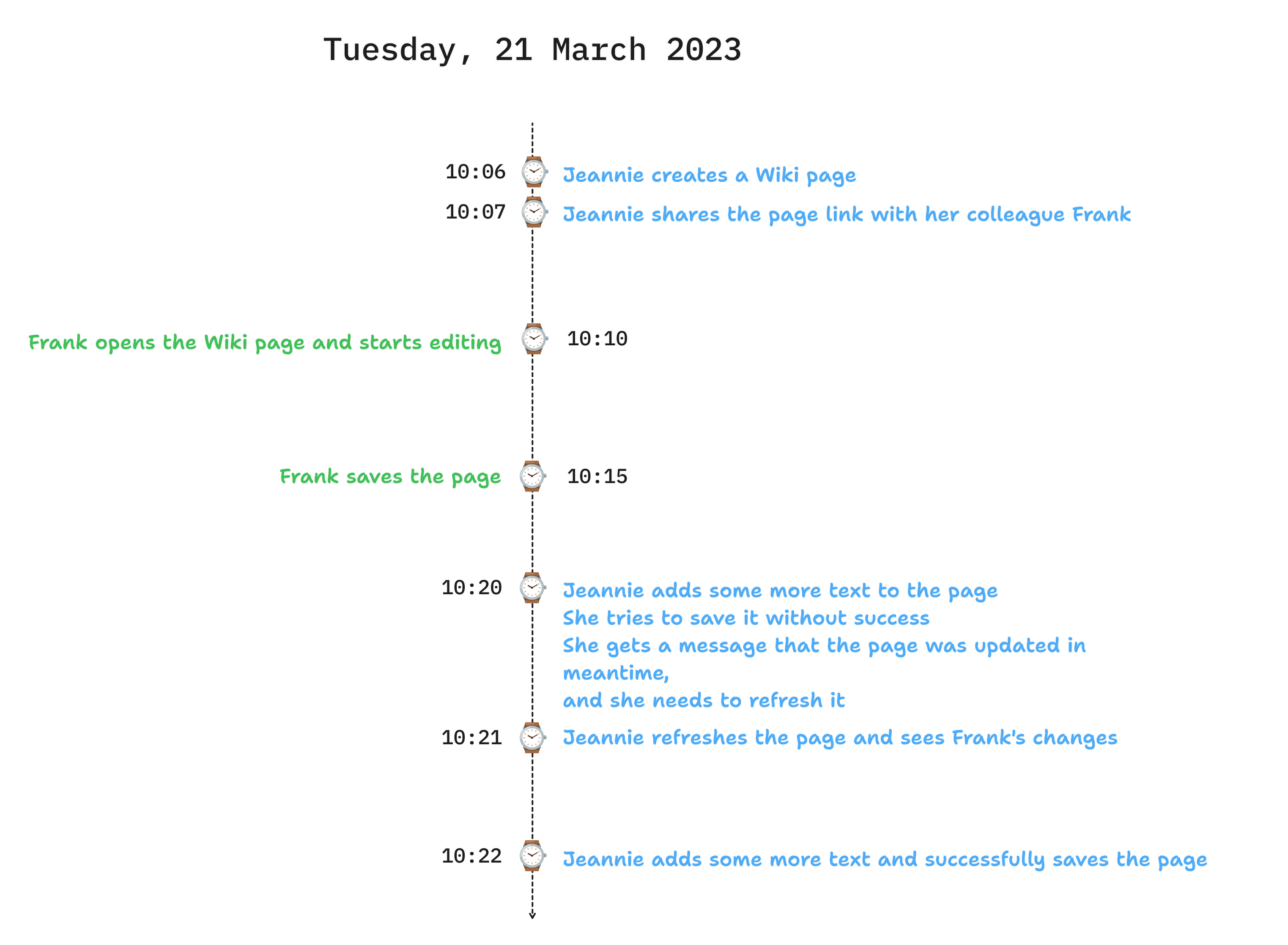
In this article, we will show you how to design and implement a REST API that can handle concurrent requests when updating the same resource.
We also provided a sample code that demonstrates how to implement this in a real-world-like scenario of Wiki page management API.
What's the problem to solve?
The issue we want to tackle is known as "lost updates". When do such updates happen? When the same resources are attempted to be updated by multiple clients at the same time. What happens in such cases, if you don't have any special handling? The last update wins.
Let's illustrate this with an example of two different users trying to update the same Wiki article:
The issue with this flow is that the User2 was able to update the document, without even caring if the document might have changed in the meantime. User1's update was lost.
The solution is to make one of the two users (User2 in this case) angry 🙂.
How's that? Let's read on.
Optimistic locking - the solution to "lost updates"
You may have noticed that some software you used in the past had a mechanism to prevent "lost updates". Let's take a Wiki as an example. As a Wiki page is shared among your teammates, and as writing a Wiki page is a collaborative effort, and additionally takes a while to write, the chances are that someone else may have updated the page as of the time you were writing your changes.
Usually such tools will let you know that you need to sync your changes with the latest version of the page. This may lead to conflicts that you need to resolve, before saving your work.
You may have expereinced the same by using Git Source Code Versioning tool. If you try to push your changes to a remote repository, and someone else pushed their changes to the same branch as you, you will get an error message saying that you need to pull the remote changes first.
The beauty of this design is that it forces you to base your work on the work of others, whether you like it or not.
The design implemented in both cases is called "optimistic locking". Simply put, it's an assumption that the transactions will not interfere often, and that there is no need to lock the resources they may change. Instead, transactions are allowed to change the data, but before they are committed, there is a check to see if the data has been changed in the meantime. Non locking approach brings a performance benefit.
Later in this article, we will show an example of the Wiki page management API, and we will use optimistic locking to prevent "lost updates".
Technical means we will use to implement optimistic locking are ETag and If-Match HTTP headers.
Let's learn first about ETags first.
What are ETags?
ETag (stands for Entity Tag) is an HTTP response header. The value of
this header is an opaque identifier assigned by servers to specific versions of resources. If the content of the resource changes, the ETag changes as well.
ETag is used for caching purposes, as well as for concurrency control. An example of an ETag header:
GET /api/v1/documents/123 HTTP/1.1
Host: example.com
Accept: application/json
HTTP/1.1 200 OK
Content-Type: application/json
ETag: "bfc13a64729c4290ef5b2c2730249c88ca92d82d"
{
"id": 123,
"title": "My document",
"content": "This is my document"
}
There are 2 types of ETags: weak and strong.
Strong ETags imply byte-by-byte equality. Weak ETags imply semantic equality.
Technically, weak ETags are prefixed with W/. Strong ETags are not prefixed.
An example of a weak ETag would be W/"bakck3", whereas an example of a strong ETag would be "bfc13a64729c4290ef5b2c2730249c88ca92d82d".
Strong ETags are usually preferred, as they are more reliable. However, they are more expensive to compute
As strong ETags are preferred by If-Match header, we will use them in our example.
Read more about ETags in MDN Web Docs.
Control concurrency with If-Match HTTP request header
If-Match request header makes the request conditional.
If-Match contains list of ETags. The flow works like this:
- A user requests a resource from the server, and the server responds with the resource and its
ETag. - User makes local modification to the resource
- User sends the modified resource to the server, along with the
ETagof the resource it received from the server. ThisETagis sent inIf-Matchheader. - Server checks if the
ETaginIf-Matchheader matches theETagof the resource on the server. If they match, the server proceeds with handling the request. - If the
ETags don't match, the server responds with412 Precondition Failedresponse.
Let's illustrate this with an example based on our Wiki page management API:
Real-world example
As mentioned earlier, we designed the Wiki page management API. It provides the following user experience:

Design & Implementation
To be able to achieve such a user experience, we came up with the following API design:
- We will need 2 API operations, one to save and one to get a Wiki page
- We will use strong ETags and If-Match HTTP headers
Saving a Wiki page
We designed saving a Wiki page so that it will use an idempotent PUT HTTP method. This method will be used to create a new document,
as well as to update an existing one. Clients are allowed to set the id of a Wiki page.
The following is a flowchart of how the API operation was implemented:
The algorithm above strictly follows the RFC 7232 specification.
Getting a Wiki page
Getting a Wiki page is far simpler. Using standard GET HTTP method, we will return the Wiki page with the provided wikiId.
If there's no such page with the provided wikiId, we will return 404 Not Found.
The following is a flowchart of how the API operation was implemented:
Sample code
On our GitHub, we've published a sample project that implements the described API. The sample code is written in Kotlin using Vert.x toolkit. It requires having JDK 11 or newer installed
The code contains a README file, with instructions on how to run the app and how to interact with it
What now?
Are there use-cases where your API consumers can manage the same resource? To avoid data loss, use optimistic locking.
One Last Thing!
We built Sheetty Time Tracker, a tool inspired by the ideas we've discussed in this article. Our users love its simplicity, fun design, and intuitive interface.
Why Choose Sheetty?
- Save Time: Streamline your time-tracking process with ease.
- Save Money: Optimize your productivity and reduce wasted hours.
- Enjoy the Experience: Track your time in a way that feels effortless and enjoyable.
Ready to transform how you manage your time? Try Sheetty Time Tracker today!
